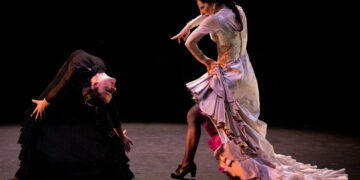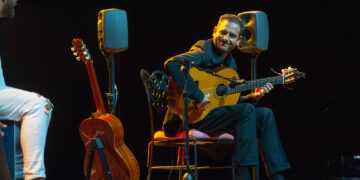|
XV FESTIVAL DE JEREZ
|
|
Text: Estela Zatania In its final stretch, the fifteenth Festival de Jerez continues to provoke and entertain the many visitors who have come to enjoy it, even though someone forgot to turn the rain off. At eleven o’clock in the morning at the Centro Andaluz de Flamenco, Faustino Núñez helped beginners understand some of the basics of flamenco with his entertaining talk, and at 5 in the afternoon, at the same venue, veteran dancer from Utrera, José de la Vega, shared anecdotes and memories with the people in attendance. In the evening, two noteworthy shows were presented at the Sala Paúl and the Villamarta theater respectively. CHONI “LA GLORIA DE MI MARE” Simply perfect. When I saw the debut of “La Gloria de mi Mare” a few months ago at the Bienal de Flamenco de Sevilla, I thought it was an excellent piece of work, but last night at the Sala Paúl the polishing-up it has undergone since then has resulted in a perfect jewel in every sense; a tribute to the Andalusian character which could easily become a classic.
Four characters who revel in the exaggerated surreal Andalusian personality that has always been a part of flamenco, although many now paint that as mere political manipulation promoted by Franco. However, the first flamenco works, lest we forget, were in the light vein, with the folkloric “Calles de Cádiz”, a work singularly lacking in conceptuality, that set the standard some eighty years ago. The depressing blackness of so many current flamenco works is an immature, misguided fashion destined to fall from its own weight, because flamenco can’t deny its very history and personality. Alicia Acuña is surprisingly versatile, singing (sevillanas rocieras, or a siguiriya “Yo no aguanto a tu mare”, in direct reference to the dancer’s meddlesome mother, sung as if her life depended on it), dancing (a pas de deux in bata de cola with Choni), as a comic actress or engaging in a facing-off with castanets in which even the famous slow-motion knife-fight from Gades’ Bodas de Sangre is satirized. Where do these people get ideas like this?…so much creativity… On the program it reads: “Original idea: Asunción Pérez”, in other words, La Choni, the dancer who is at the center of the story, and also manages to interpret some actual dances such as a guajira (with parasol), a caña, a danza mora with chin-chines, typical of the era, or what is certainly the first comic siguiriya in history. The stage direction, also a crucial element in this show, is the work of Estrella Távora. On the downside, it’s a lot of dialogue, and many Andalusian references for non-Spanish theater-goers, but plenty of projects much less flamenco and of lower quality have been seen at the Festival de Jerez. A cleverly crafted sentimental ending unfolds when you realize the whole thing was a flashback, the meddlesome mother no longer exists, and the dancer remembers her only with the greatest tenderness. Anyone who doesn’t get caught up in the magic of “La Gloria de mi Mare” has no sense of humor, and no heart. MERCEDES RUIZ “PERSPECTIVAS” Dance: Mercedes Ruiz. Cante: David Lagos, Melchora Ortega, Miguel Lavi. Guitar: Santiago Lara, Paco Lara. Percussion: Perico Navarro. Palmas: Javier Peña. Original idea and choreography: Mercedes Ruiz. Libretto: Francisco López. Music director: Santiago Lara.
The show is a collection of independent pieces with no story line beyond that of offering a variety of the dancer’s “Perspectivas”, as the title indicates. Everything begins with an audiovisual sequence of Carmen Amaya arriving in Spain, but this is not linked to the rest of the work, although there are various projections on the backdrop…images of flowers, colors or simply the word “vivir” (“live”) in outsized letters. The team of singers is noteworthy. David Lagos continues to be a young singer waiting to be discovered by Jerez, although he has long been admired by flamenco fans from outside town for his rich flamenco voice, his knowledge and his ability to sing anything well (even in foreign languages as was required in at least one show mounted by Israel Galván). His wife, singer Melchora Ortega, was pulled out of semi-retirement after being practically absent from the day-to-day activities of flamenco life following her winning the cante prize of the Bienal in 1998, and another Jerez singer, Miguel Lavi, has appeared in three shows in the Festival de Jerez this year, all outstanding performances on his part. Fandangos de Huelva, taranto, percussion in bulerías compás for the serrana sung by Lagos, soleá apolá… Mercedes knows the value of subtlety, although she makes use of speed-ups for easy applause. A lovely colombiana is sung by David, and Mercedes dances tientos with the cante of marianas, a seldom-heard variant, as well as tangos of Triana, Granada… Four quarter time continues to be the center of attention with an old-style rumba, the kind there used to be before the aggressive rumba catalana took over these laidback Caribbean rhythms. Mercedes appears in a shiny gold-colored men’s suit and broad-brimmed hat looking a lot like Fred Astaire, to reprise the zapateado that earned her an important prize in Córdoba in 2001, while the music of Santiago and Paco Lara, with beautiful modulations, rounds out the picture. From this point on, the show begins to lose steam, giving in to certain frivolous excess, and an almost circus-like atmosphere when Mercedes tries her hand…and voice…at a Cádiz-style tanguillo rap which she uses to present the various members of the group. The surprising ending consisted of the song “Gracias a la Vida” whose lyrics were projected in English, French and Japanese. Later on in the evening, at the Peña Terremoto, we were able to take in the cante of David Carpio and Juan Fajardo Moneo “El Momo”. |
Descubre más desde Revista DeFlamenco.com
Suscríbete y recibe las últimas entradas en tu correo electrónico.



 Half vaudeville, half drama and half flamenco makes three “halves”, and that’s just how it is, because “La Gloria de mi Mare” is much greater than the sum of its parts. One dancer, one singer and one guitarist, all of a competent level, and a first-class comic actor, Juanjo Linares, weave a crazy quilt worthy of Capra about a young flamenco dancer and her unbearably nosy chatterbox of a meddling mother who is reliving her lost youth through her daughter. Raúl Cantizano and Alicia Acuña, guitarist and singer, play the part of an impresario and his wife.
Half vaudeville, half drama and half flamenco makes three “halves”, and that’s just how it is, because “La Gloria de mi Mare” is much greater than the sum of its parts. One dancer, one singer and one guitarist, all of a competent level, and a first-class comic actor, Juanjo Linares, weave a crazy quilt worthy of Capra about a young flamenco dancer and her unbearably nosy chatterbox of a meddling mother who is reliving her lost youth through her daughter. Raúl Cantizano and Alicia Acuña, guitarist and singer, play the part of an impresario and his wife. Jerez fans filled the Villamarta theater to see the new show of Mercedes Ruiz, the only female dancer from Jerez more or less making a name for herself in the world of flamenco dance. It’s the fourth time she has been granted this prestigious venue with a group of her own, and in 2007 her show “Juncá” received the critic’s choice prize.
Jerez fans filled the Villamarta theater to see the new show of Mercedes Ruiz, the only female dancer from Jerez more or less making a name for herself in the world of flamenco dance. It’s the fourth time she has been granted this prestigious venue with a group of her own, and in 2007 her show “Juncá” received the critic’s choice prize.






















